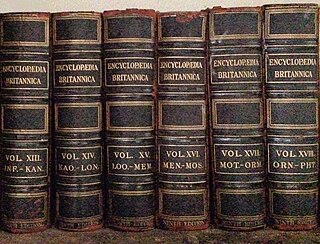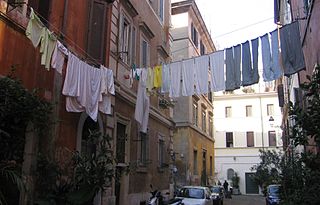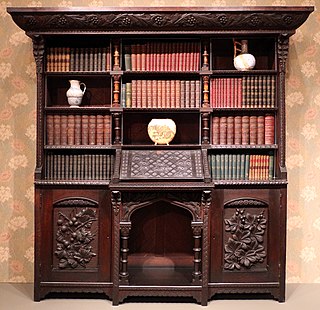
An encyclopedia or encyclopædia is a reference work or compendium providing summaries of knowledge from either all branches or from a particular field or discipline. Encyclopedias are divided into articles or entries that are often arranged alphabetically by article name and sometimes by thematic categories. Encyclopedia entries are longer and more detailed than those in most dictionaries. Generally speaking, unlike dictionary entries—which focus on linguistic information about words, such as their etymology, meaning, pronunciation, use, and grammatical forms—encyclopedia articles focus on factual information concerning the subject named in the article's title.

Laundry refers to the washing of clothing and other textiles. Laundry processes are often done in a room reserved for that purpose; in an individual home this is referred to as a laundry room or utility room. An apartment building or student hall of residence may have a shared laundry facility such as a tvättstuga. A stand-alone business is referred to as a self-service laundry. The material that is being washed, or has been laundered, is also generally referred to as laundry.

A straitjacket is a garment shaped like a jacket with long sleeves that surpass the tips of the wearer's fingers. Its most typical use is restraining people who may cause harm to themselves or others. Once the wearer slides his or her arms into the sleeves, the person assisting the wearer crosses the sleeves against the chest and ties the ends of the sleeves to the back of the jacket, ensuring the arms are close to the chest with as little movement as possible.

The cubit is an ancient unit of length that had several definitions according to each of the various different cultures that used the unit. These definitions ranged between 444 and 529.2 mm. The unit was based on the forearm length from the tip of the middle finger to the bottom of the elbow. Cubits of various lengths were employed in many parts of the world in antiquity, during the Middle Ages and as recently as Early Modern Times. The term is still used in hedgelaying, the length of the forearm being frequently used to determine the interval between stakes placed within the hedge.

Al-ʻUzzā was one of the three chief goddesses of Arabian religion in pre-Islamic times and was worshiped by the pre-Islamic Arabs along with Allāt and Manāt. A stone cube at aṭ-Ṭā’if was held sacred as part of her cult. She is mentioned in the Qur'an Sura 53:19 as being one of the goddesses that people worshiped.

A blouse is a loose-fitting upper garment that was formerly worn by workmen, peasants, artists, women, and children. It is typically gathered at the waist or hips so that it hangs loosely ("blouses") over the wearer's body. Today, the word most commonly refers to a girl's or woman's dress shirt It can also refer to a man's shirt if it is a loose-fitting style, though it rarely is. Traditionally, the term has been used to refer to a shirt which blouses out or has an unmistakably feminine appearance.

A buckler is a small shield, up to 45 cm in diameter, gripped in the fist with a central handle behind the boss. While being used in Europe since antiquity, it became more common as a companion weapon in hand-to-hand combat during the Medieval and Renaissance periods. Its size made it poor protection against missile weapons but useful in deflecting the blow of an opponent's weapons, binding his arms or hindering his movements.

A chandelier is a branched ornamental light fixture designed to be mounted on ceilings or walls. Chandeliers are often ornate, and normally use incandescent light bulbs, though some modern designs also use fluorescent lamps and recently LEDs.

A petticoat or underskirt is an article of clothing, a type of undergarment worn under a skirt or a dress. Its precise meaning varies over centuries and between countries.

Fustian is a variety of heavy cloth woven from cotton, chiefly prepared for menswear. It is also used figuratively to refer to pompous, inflated or pretentious writing or speech, from at least the time of Shakespeare. This literary use is because the cloth type was often used as padding, hence, the purposeless words are fustian.

A clothes horse, sometimes called a clothes rack, drying horse, clothes maiden, garment donkey, drying rack, drying stand, Frostick, airer, or (Scots) winterdyke, is a frame upon which clothes are hung after washing, indoors or outdoors, to dry by evaporation. The frame is usually made of wood, metal or plastic. It is a cheap low-tech piece of laundry equipment, as opposed to a clothes dryer, which necessitates electricity.

A sleeveless shirt is a shirt manufactured without sleeves, or whose sleeves have been cut off. Sleeveless shirts are worn by people of any gender, depending on the style. They are used as undershirts, or worn by athletes in sports such as track and field and triathlon.

A festoon is a wreath or garland hanging from two points, and in architecture typically a carved ornament depicting conventional arrangement of flowers, foliage or fruit bound together and suspended by ribbons. The motif is sometimes known as a swag when depicting fabric or linen.
In alchemy, cadmia is an oxide of zinc (tutty) which collects on the sides of furnaces where copper or brass was smelted, and zinc sublimed. The term is also applied to an ore of cobalt.

Chapeau is a French term signifying a hat or other covering for the head.

A fullo was a Roman fuller or laundry worker, known from many inscriptions from Italy and the western half of the Roman Empire and references in Latin literature, e.g. by Plautus, Martialis and Pliny the Elder. A fullo worked in a fullery or fullonica. There is also evidence that fullones dealt with cloth straight from the loom, though this has been doubted by some modern scholars. In some large farms, fulleries were built where slaves were used to clean the cloth. In several Roman cities, the workshops of fullones, have been found. The most important examples are in Ostia and Pompeii, but fullonicae also have been found in Delos, Florence, Fréjus and near Forlì: in the Archaeological Museum of Forlì, there is an ancient relief with a fullery view. While the small workshops at Delos go back to the 1st century BC, those in Pompeii date from the 1st century AD and the establishments in Ostia and Florence were built during the reign of the Emperors Trajan and Hadrian.

A wardrobe or armoire is a standing closet used for storing clothes. The earliest wardrobe was a chest, and it was not until some degree of luxury was attained in regal palaces and the castles of powerful nobles that separate accommodation was provided for the apparel of the great. The name of wardrobe was then given to a room in which the wall-space was filled with closets and lockers, the drawer being a comparatively modern invention. From these cupboards and lockers the modern wardrobe, with its hanging spaces, sliding shelves and drawers, evolved slowly.
USS Harlequin (AM-365) was an Admirable-class minesweeper built for the United States Navy during World War II. She served in the Atlantic during World War II. She was decommissioned in May 1946 and placed in reserve. While she remained in reserve, Harlequin was reclassified as MSF-365 in February 1955 but never reactivated. In October 1962, she was sold to the Mexican Navy and renamed ARM DM-20. From 1976–1978 she was converted to an oceanographic research vessel and renamed ARM Oceanográfico (H02) around the same time. In 1993 she was renamed ARM General Pedro María Anaya (A08). In the late 1990s, she was again renamed, this time to ARM Aldabaran (BE02), as a school ship. As of 2007, Aldebaran remained in active service with the Mexican Navy.
Plynteria was a festival of ancient Greece celebrated at Athens every year, on the 22nd of Thargelion, in honor of Athena Polias, with the heroine Aglauros, whose temple stood on the Acropolis. The festival's name came from plynein (πλύνειν), a Greek verb meaning "to wash".

Clothing in ancient Greece primarily consisted of the chiton, peplos, himation, and chlamys. Ancient Greek men and women typically wore two pieces of clothing draped about the body: an undergarment and a cloak. Ancient Greek clothing was mainly based on necessity, function, materials, and protection rather than identity. Thus, clothes were quite simple, draped, loose-fitting and free flowing. Customarily, clothing was homemade and cut to various lengths of rectangular linen or wool fabric with minimal cutting or sewing, and secured with ornamental clasps or pins, and a belt, or girdle (zone). Pieces were generally interchangeable between men and women. However, women usually wore their robes to their ankles while men generally wore theirs to their knees depending on the occasion and circumstance.


















